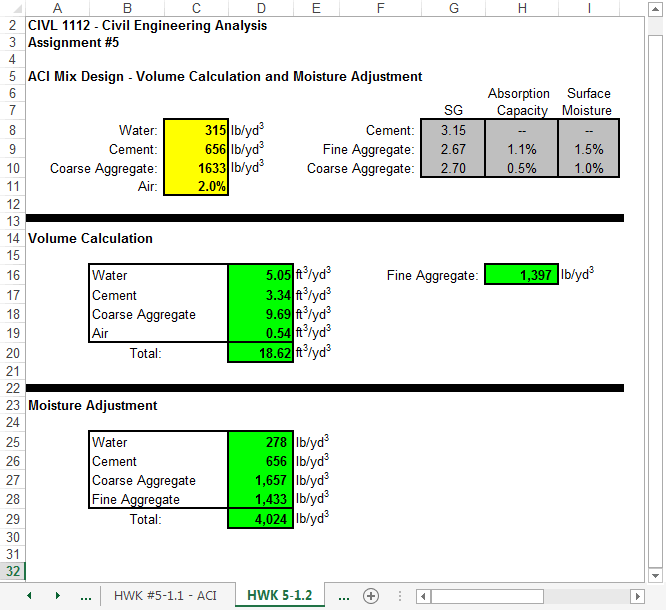|
"Sixty years ago I knew everything; now I know nothing; education is a
progressive
discovery of our own ignorance." - Will Durant
Objective
The purpose of this assignment is twofold: (1) use the ACI concrete mix design procedure; and
(2) to continue to develop your
spreadsheet skills.
Part 1: Use the ACI method for concrete mix
design to proportion a 1 yd3 of concrete. Compute the weight of
each mix component by hand to meet the follow specifications:
The concrete is required for an interior
column. The 28-day compressive strength should be 4,000 psi. The slump should be between 3
and 4 inches and the maximum aggregate size should not exceed 1 inch. The properties of the
materials are as follows:
- Cement
: Type I, specific gravity = 3.15
- Coarse
Aggregate: Bulk specific gravity (SSD) = 2.72;
absorption capacity = 1.3%;
dry-rodded unit weight = 103 lb/ft3;
surface moisture = 1%
- Fine
Aggregate: Bulk specific gravity (SSD) = 2.67;
absorption capacity = 1.5%;
fineness modulus = 2.70
surface moisture = 2%
Follow the
homework format given in class and report the weigh of
cement, water, coarse aggregate, and fine aggregate required per cubic yard for this
application. If we were to mix this concrete in the lab using the yellow mixer
(about 1 cubic foot in volume), what would be the required weigh of cement, water, coarse
aggregate, and fine aggregate?
Part 2: Develop a Excel spreadsheet that computes the amount of fine aggregate
using the ACI Mix Design volume method, given the amounts of water, cement, and
coarse aggregate and then adjusts each mix component for moisture content.
The concrete is required for an interior
column. The 28-day compressive strength should be 5,000 psi. The slump should be between
1
and 2 inches and the maximum aggregate size should not exceed
¾ inch. The properties of the
materials are as follows:
- Cement
: Type I, specific gravity = 3.15
- Coarse
Aggregate: Bulk specific gravity (SSD) = 2.70;
absorption capacity = 0.5%;
dry-rodded unit weight = 96 lb/ft3;
surface
moisture = 1%
- Fine
Aggregate: Bulk specific gravity (SSD) = 2.67;
absorption capacity = 1.1%;
fineness modulus = 2.70
surface
moisture = 1.5%
Your Excel spreadsheet should be configured similar to the one
shown below. The data in the yellow boxes are computed using steps 1-7 of the
ACI Mix Design procedure. The data in the gray boxes are the material
parameters. The values shown in the green boxes are the results of embedded
Excel functions that you should program.
In the Volume Calculation section, round all of your results to
two decimal places. The final component weights, in both the Volume Calculation
and Moisture Adjustment sections, should be rounded to the nearest integer. The
calculations shown in the spreadsheet below are the same as an example problem
in the
ACI Mix Design
notes. Click
here to download a template copy of the following
spreadsheet.

Part 3. Read the Chapters
9 and 10 in the "A Mind for
Numbers" by Barbara Oakley.
Additional Resources
Microsoft Excel includes a built-in user's manual and tutorial. They are available
through the Help option at the right end of Excel's main command line. In addition, a
brief Excel manual is available from the
CIVL 1112 website.
A web page describing the CIVL 1112
Excel Homework
Policy is available. Read it before you turn in each assignment this semester. You
will be graded according to the policy outlined in it.
Coversheet for homework
This website was originally
developed by
Charles Camp for
CIVL
1112.
This site is maintained by the
Department of Civil Engineering
at the University of Memphis.
Your comments and questions are welcomed.
|



